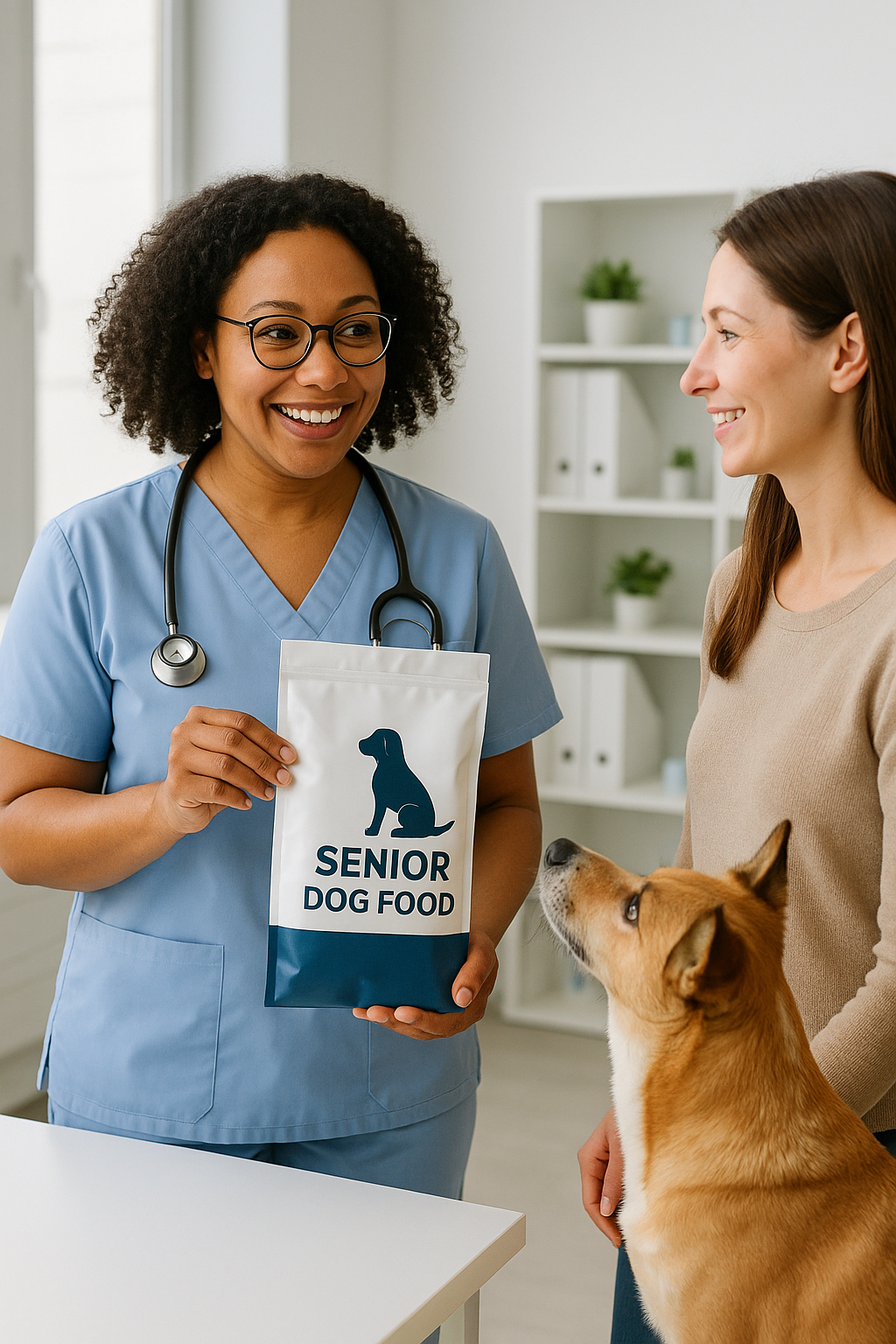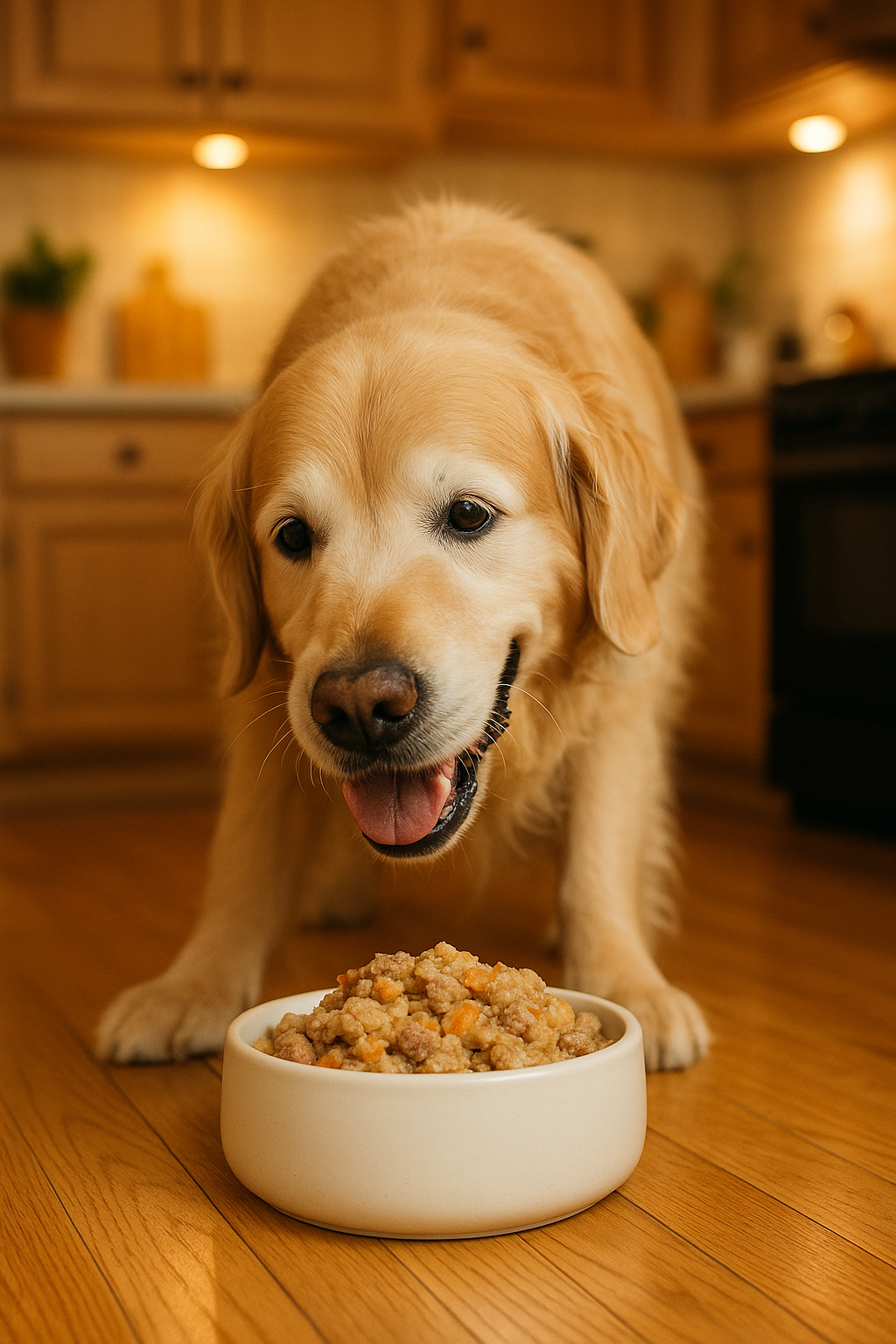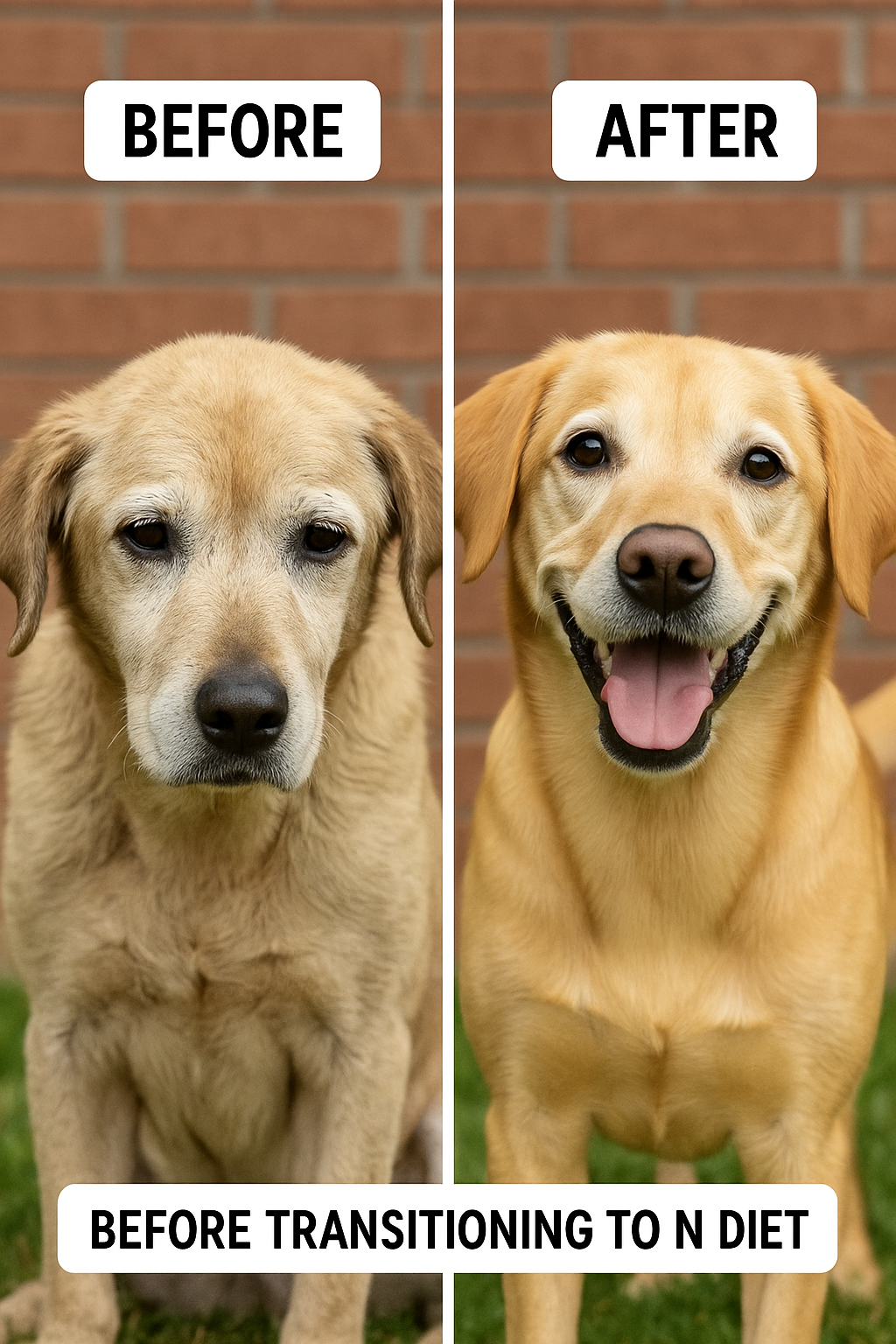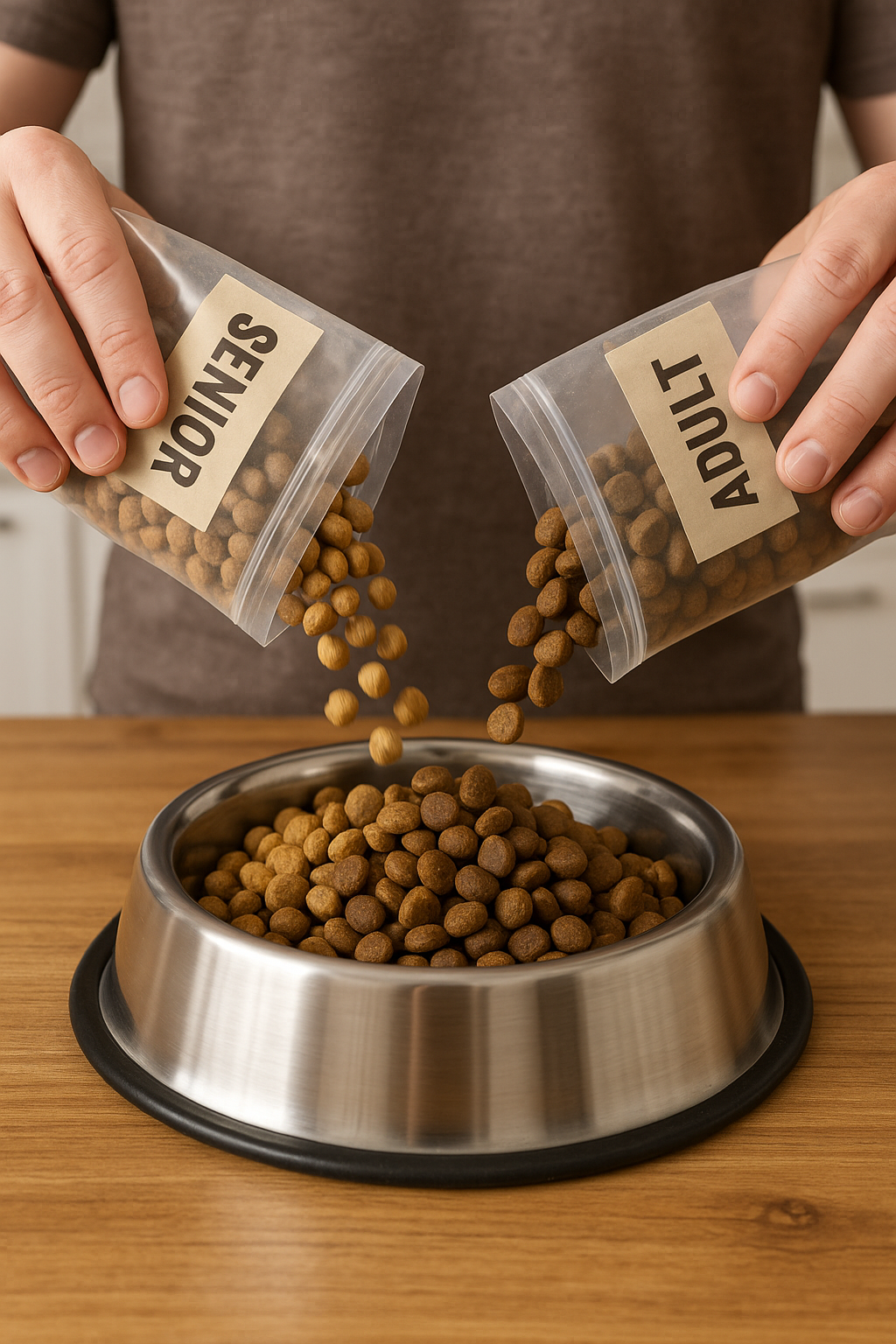Table of Contents
🐶 Introduction:
Why Your Dog’s Diet Must Change with Age
Just like humans, dogs experience aging—and with age comes changes in nutrition. If you’re wondering how to transition your dog to a senior diet without upsetting their stomach or losing their appetite, you’re in the right place. This guide walks you through everything from choosing the right food to adjusting your feeding schedule the vet-approved way.
But here’s the catch: abruptly changing your dog’s food can lead to digestive distress, food refusal, or nutrient imbalance. That’s why this post will guide you step-by-step on how to make the switch safely and effectively.
🐕 1. What Makes a Dog “Senior”?
Small breeds: Senior at 9–10 years
Medium breeds: Senior at 7–8 years
Large/giant breeds: Senior at 5–6 years
Key aging signs:
- Slower movement or hesitation when jumping
- Weight gain or loss
- Cloudy eyes or hearing issues
- More naps and lower energy
- Sensitive digestion or allergies
Once these signs appear, it’s time to evaluate their diet.
🍽️ 2. Key Nutritional Needs of Senior Dogs
How to Transition Your Dog to a Senior Diet Safely
- Joint health (glucosamine, chondroitin, omega-3s)
- Heart and kidney health (low sodium/phosphorus)
- Digestive ease (high fiber, probiotics)
- Weight control (lower fat, quality protein)
- Brain function (antioxidants, MCTs, DHA)
Must-Have Nutrients:
- Lean Protein (chicken, fish, turkey)
- Omega-3 Fatty Acids (fish oil, flaxseed)
- Soluble Fiber (pumpkin, sweet potato, oats)
- Antioxidants (blueberries, spinach)
- Calcium & Vitamin D
🚨 3. Signs It’s Time to Change Your Dog’s Diet
- Frequent upset stomach or loose stools
- Excessive shedding or dull coat
- Stiff joints or difficulty walking
- Sudden weight gain/loss
- Increased thirst or urination
- Foul breath or dental issues
- Lethargy or cognitive decline
If your dog shows 2 or more of these symptoms, it’s time to discuss a senior diet with your vet.

How to Transition Your Dog to a Senior Diet Safely
🛒 4. Choosing the Right Senior Dog Food
🏷️ What to Look For on the Label:
- “Complete & Balanced” (AAFCO-approved)
- Formulated for “senior” or “mature” dogs
- Limited filler ingredients (avoid corn, soy, wheat)
- Named protein sources (e.g., “chicken meal,” not “meat by-products”)
- Includes joint support supplements (glucosamine, MSM)
✅ Vet-Recommended Brands (USA):
- Hill’s Science Diet 7+
- Royal Canin Aging Care
- Blue Buffalo Life Protection
- Nutro Ultra Senior
- Purina Pro Plan Bright Mind
💡 Tip: Avoid high-fat diets unless your dog is underweight.
📆 5. Step-by-Step Transition Plan (7–10 Days)
Changing dog food should be done gradually to avoid vomiting, diarrhea, or refusal to eat.
| Day | Old Food | New Senior Food |
|---|---|---|
| 1-2 | 75% | 25% |
| 3-4 | 50% | 50% |
| 5-6 | 25% | 75% |
| 7+ | 0% | 100% |
✅ Feed at the same time daily
✅ Watch for allergic reactions or GI upset
✅ Increase hydration
🥣 6. How to Mix Old & New Food Safely
- Start with a small spoonful of new food
- Mix thoroughly to disguise the smell and taste
- Add warm (not hot) water to soften kibble if your dog has dental issues
- Don’t feed from a dirty or unfamiliar bowl
If your dog refuses food, step back to the previous mix ratio.
🏠 7. Homemade vs. Commercial Senior Dog Food
| Type | Pros | Cons |
|---|---|---|
| Commercial | Convenient, balanced, easy to store | Contains preservatives, less custom |
| Homemade | Full control of ingredients | Time-consuming, risk of imbalance |
👉 Homemade recipes must include:
- Lean protein
- Soft-cooked vegetables
- Complex carbs
- Calcium supplement (e.g., eggshell powder)
- Omega-3 (fish oil, flax)
Best Recipe Examples:
- Chicken & Pumpkin Bowl
- Turkey & Sweet Potato Mash
- Fish & Brown Rice Blend
Check our post: “Senior Dog Food Recipes” for full recipes.
❌ 8. Common Mistakes to Avoid
- Switching food too fast
- Feeding treats with allergens
- Ignoring portion control
- Overfeeding fiber
- Giving table scraps
- Not reading ingredient labels
- Skipping vet consultation
💊 9. Supplementing a Senior Diet
Senior dogs often benefit from:
- Joint support: Glucosamine, Chondroitin, MSM
- Brain health: DHA, SAM-e
- Digestion: Probiotics, pumpkin
- Skin/Coat: Omega-3, Biotin
✅ Always ask your vet before adding supplements
✅ Use chewable or powder forms for easy feeding

How to Transition Your Dog to a Senior Diet Safely
🖨️ 10. Printable Senior Dog Diet Tracker (Free)
Track:
- Daily food type
- Transition ratios
- Symptoms (gas, stool changes, appetite)
- Weight weekly
- Vet recommendations
👉 [Download Tracker Sheet – Coming Soon on SeniorPawsGuide.com]
🧬 11. How Aging Affects Your Dog’s Metabolism and Digestion
As dogs age, their bodies undergo internal changes that directly affect how they process food. These include:
- Slower metabolism – leading to easier weight gain
- Weakened digestive enzymes – making it harder to digest fat and complex proteins
- Reduced insulin sensitivity – which can increase the risk of diabetes
- Weaker immune function – requiring higher antioxidant intake
- Dental deterioration – making hard kibble painful to chew
👉 A senior diet compensates for these changes with easily digestible proteins, lower fat, and added fiber.
🧪 12. Understanding Dog Food Labels: Red Flags to Watch Out For
When choosing senior food, don’t get fooled by marketing buzzwords. Learn how to decode ingredients and avoid harmful fillers.
🚫 Avoid:
- Artificial colors or preservatives (BHA, BHT)
- Meat by-products (non-specific sources)
- Corn gluten meal or soy protein isolate
- High salt content
✅ Prefer:
- Named meats (“chicken meal,” “salmon”)
- Whole grains or legumes (oats, sweet potato)
- Natural preservatives (mixed tocopherols)
- Fortified with joint and heart supplements
🐾 Look for AAFCO certification: it ensures the food meets minimum standards for senior dogs.
American Kennel Club: Senior Dog Nutrition
PetMD: Diet Tips for Aging Dogs
WSAVA Global Nutrition Guidelines
📋 16. Sample Weekly Meal Plan (Commercial + Homemade Blend)
How to Transition Your Dog to a Senior Diet Safely
Day Morning (Dry/Wet Food) Evening (Homemade Add-On) Mon Hill’s 7+ Chicken Kibble Turkey & Sweet Potato Mash Tue Royal Canin Aging Wet Food Steamed Carrots + Fish Oil Wed Blue Buffalo Senior Blend Pumpkin + Bone Broth Thu Nutro Ultra Senior Egg & Spinach Soft Mix Fri Purina Bright Mind Lamb & Oatmeal Delight Sat Hill’s 7+ + Flaxseed Shredded Chicken & Peas Sun Mix of Wet & Dry Fish + Brown Rice Bowl
This combination supports both nutritional balance and variety, improving your dog’s appetite and nutrient intake.
⚖️ 17. Portion Control: How Much Should a Senior Dog Eat?
Senior dogs typically require 20–25 calories per pound of body weight daily.
Example:
- 50 lb senior dog = ~1,000–1,250 calories/day
Key Tips:
- Split food into 2–3 meals/day
- Use a measuring cup, not an estimate
- Monitor your dog’s Body Condition Score (BCS) monthly
- Adjust intake based on activity and weight changes
⚠️ Overfeeding leads to joint stress, diabetes, and reduced lifespan.
🧼 18. Clean Transition Practices: Hygiene & Bowl Safety
An often-overlooked part of transitioning diet is cleanliness:
- Wash food and water bowls daily with hot soapy water
- Avoid plastic bowls (they retain bacteria)
- Use stainless steel or ceramic bowls
- Rinse out leftover wet food to avoid spoilage or flies
- Don’t mix old food that’s been left out for hours
🧑⚕️ 19. When to Consult the Vet During Diet Transition
Call your vet if:
- Your dog has diarrhea for more than 48 hours
- Your dog refuses to eat for over 2 days
- Vomiting or bloating occurs
- Sudden weight drop of more than 5%
- You’re unsure about portion size or supplements
Vets can also recommend prescription senior diets (e.g., renal, hepatic, or cardiac-support formulas).
📱 20. Recommended Mobile Apps to Track Senior Diet
Make your feeding process easier with free tracking apps:
- Pawtrack – Track meals, meds, weight, and vet visits
- DoggyBites – Log food ingredients and allergies
- Pet First Aid (Red Cross) – Emergency diet & health resources
- MyPet Reminders – Set food schedule alerts
❓ FAQs
Q1. What age should I switch to senior dog food?
Typically between 7–10 years old, depending on breed size.
Q2. Can I mix wet and dry senior food?
Yes! Mixing can enhance hydration and palatability.
Q3. What if my dog refuses the new food?
Slow the transition. Try warming it or adding bone broth.
Q4. Is grain-free better for senior dogs?
Only if your dog has a confirmed grain allergy. Whole grains like oats and brown rice are beneficial for many senior dogs.
🐾 12. Final Tips from Vets
- Stick to a routine feeding schedule
- Watch for food refusal—it may signal illness
- Hydration is key—consider adding wet food
- Monitor body condition score (BCS) monthly
- Avoid treats over 10% of daily intake
✅ Conclusion
Transitioning your dog to a senior diet isn’t a quick switch—it’s a gradual journey that can extend their lifespan and improve quality of life.
The right balance of:
- High-quality nutrients
- Proper transition pacing
- Vet-approved supplements
- And close observation
…can help your senior pup stay healthier, happier, and more active.
🎯 Start the transition this week—and see the difference in your dog’s energy, movement, and mood.
🔗 Related Posts :
- [10 Early Signs Your Senior Dog Might Be in Pain]
- [Best Joint Supplements for Senior Dogs]
- [Vet-Approved Homemade Dog Food Recipes]
- [How to Help a Senior Dog Gain Weight Safely]











2 thoughts on “How to Transition Your Dog to a Senior Diet Safely (Vet-Approved Guide 2025)”